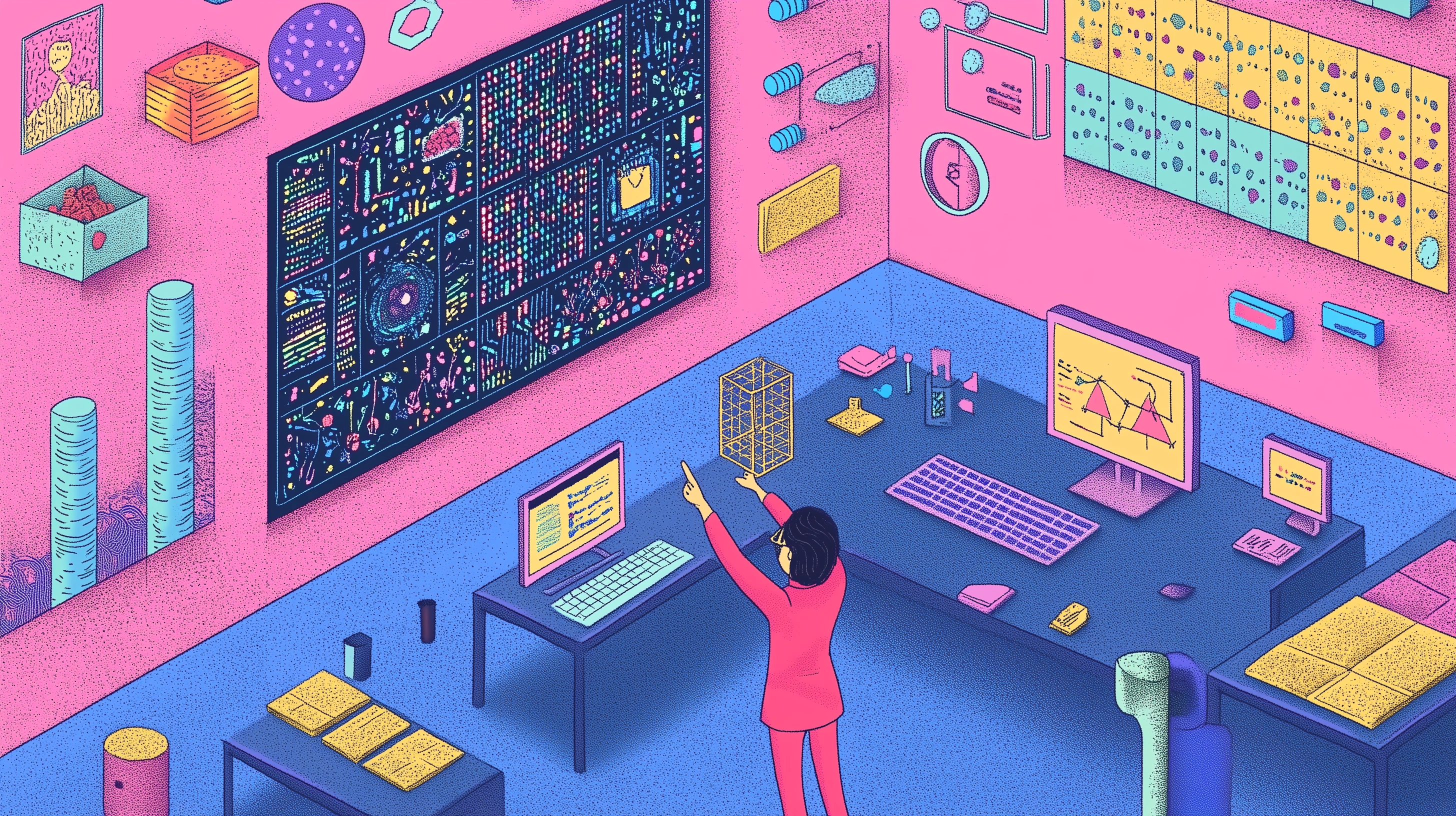How AI-first product studios are unlocking hidden value through hyper specific software

There's a gold rush happening in the most unglamorous corners of the economy.
While headlines fixate on flashy AI chatbots and art generators, smart builders are targeting data-heavy, workflow-intensive niches that are screaming for automation. Think regulatory compliance, logistics paperwork, medical billing, accounting reconciliation. These overlooked domains run on piles of data and tedious human effort. They also suffer costly errors when things slip through the cracks.
The numbers are proving this. AI development costs have plummeted while capabilities have exploded. McKinsey reports that generative AI can reduce software development time by 30-50%. AI-assisted coding with GitHub Copilot completes programming tasks 55% faster. Prototyping costs have dropped 70-80%.
This economic shift makes a $100,000 software investment look different when it can automate work equivalent to five full-time employees. We're seeing exactly that: companies investing six figures in automation and saving $300,000+ annually in labor costs. The ROI equation has fundamentally changed.
Why AI changes everything for hyper-specific software
Software used to hit a wall in very specific niches. You could digitize simple workflows, but anything involving unstructured data, natural language, or human judgment required actual humans. The business case for custom software often fell apart because the impact wasn't radical enough to justify the cost.
In the current AI era these limitations are shattered. Modern AI can parse doctor's handwritten notes, understand shipping documents, and make sense of regulatory requirements. It processes the messy, real-world data that killed traditional software projects.
The proof is in production systems already running. Aviva, a major UK insurer, deployed AI across their claims operation and slashed liability assessment time by 23 days while improving decision accuracy by 30%. The result? £60 million saved in their motor claims domain alone in 2024.
Insurance claims processing exemplifies this transformation. For decades, you needed humans to read accident reports, medical records, and policy documents. Each claim was unique. Each required judgment calls. Software could manage the data, but humans had to make the decisions.
Today, AI systems achieve 99.9% accuracy rates while reducing processing time from 15-30 minutes per claim to just 1-2 minutes. Error rates dropped from 12-18% with human processing to less than 2% with AI. The work that justified entire departments now happens automatically.
The SME opportunity most people miss
Here's what most people don't realize: small and medium-sized enterprises are driving AI adoption faster than anyone expected. Goldman Sachs found that 68% of small business owners are already using AI, up from 51% just two years ago. Another study by Intuit showed 89% of small businesses leveraging AI for automation and efficiency.
SMEs have distinct advantages in this transformation. Their pain points are obvious and well-defined. Their decision-makers can greenlight purchases quickly. The average SMB software sales cycle runs 45 days compared to 6+ months for enterprise deals. No 12-person steering committees. No endless security reviews.
The economics work because the impact is immediate and measurable. EchoStar's Hughes division built 12 AI applications that save 35,000 work hours annually and boost productivity by 25%. Markerstudy Group's call summarization app saves four minutes per call, adding up to 56,000 hours annually. Ramp's custom OCR tool processes 400,000 invoices monthly while saving 30,000 hours of manual work.
SMB IT spending reached $1.62 trillion in 2024, growing 6% year-over-year. These businesses have budget and they're actively investing. And this time the constraint isn't money but expertise. Sixty percent of SMEs cite lack of expertise in applying AI to their business as their primary barrier.
The 5-FTE automation threshold captures the magic number. When you can credibly promise to automate work equivalent to about five full-time employees, even a modest-sized company will jump at a $100,000 software purchase because it pays for itself within a year. But turning that promise into reality requires more than just AI capabilities.
What makes these AI products actually stick
Domain expertise becomes the real differentiator once the novelty of AI wears off. Research shows 71% of companies prefer vertical AI solutions for their specific industry needs, compared to only 21% opting for horizontal AI. Generic solutions fall short because they miss the nuanced requirements of specialized workflows.
Trust matters most when AI handles high-stakes decisions in compliance, finance, and operations. Users need transparency in decision-making, audit trails, and confidence the system won't create costly mistakes. An AI tool for regulatory compliance needs to embed actual regulations and update automatically when laws change. If it misclassifies a regulation or misses jurisdiction-specific nuances, users abandon it quickly.
Integration trumps flashy features every time. Businesses want solutions that slot into existing workflows, not science projects that demand complete overhauls. Adding third-party system integrations like CRM and ERP connections increases project costs by 15-25%, but it's crucial for adoption. Users embrace tools that augment their current processes and provide clear justifications for decisions.
Real-world messiness tests every system. Demos run on clean datasets. Reality involves corrupted files, edge cases, and unexpected inputs. Successful AI products invest heavily in handling these scenarios. They accurately promise "we automate 80% of the work and flag the 20% for review" rather than overselling full automation that breaks on anything outside the norm.
The best solutions provide concrete success metrics. Dashboards showing "240 hours saved this month" or "error rate reduced by 90%" both justify the ROI and build user confidence. When an accounting firm implemented AI invoice processing and cut processing time by 75% while reducing errors by 90%, they achieved full ROI within nine months. Numbers like these make it impossible to return to manual processes.
Why traditional development fails here
Traditional development approaches stumble when tackling AI-driven projects for specific niches. The fundamental problem here is knowledge gaps. Most development teams lack the deep industry understanding needed to capture requirements and corner cases. It's easy to build the "right" solution to the wrong problem.
The technical complexity compounds the challenge. Custom AI development ranges from $100,000 to $300,000 compared to $50,000 to $100,000 for traditional software. AI systems require 30-50% of initial development cost annually for maintenance versus 15-25% for traditional software. This happens because AI models drift over time and need retraining.
Recent research adds another wrinkle. A randomized controlled trial found that experienced developers using AI tools actually took 19% longer to complete complex tasks compared to working without AI. This challenges the assumption that simply giving AI tools to development teams guarantees speed improvements.
SMEs can't afford 13-month timelines and $2.7M budgets that average AI projects demand in enterprise settings. They need working solutions in weeks, not quarters. Internal teams get pulled in different directions. Generic development agencies quote 6+ month timelines for MVPs. By then, business priorities have shifted or budgets have been exhausted.
The reinvention problem wastes enormous effort. Every project rebuilds common patterns for data ingestion, AI model integration, and business logic from scratch. Teams spend time solving problems that specialized providers have already mastered rather than focusing on unique, high-value features.
The studio advantage: speed, expertise, and proven playbooks
Product studios solve these problems by bringing pre-built scaffolding and cross-niche pattern recognition. They have libraries of reusable components ready to deploy. Need user management, OCR modules, or QuickBooks integration? They've solved these challenges across multiple projects.
The timeline advantage is dramatic. Studio-incubated startups reach Series A funding in 25 months on average, compared to 56 months for traditional startups. C3 AI, a specialized AI provider, promises production trials in 8-12 weeks and full deployment in 3-6 months. This speed comes from established playbooks and proven architectures.
Cross-niche experience creates unexpected value. A studio building AI for legal contract analysis recognizes patterns that apply to insurance claims processing. They develop frameworks for human-in-the-loop workflows, data validation, and audit trails that transfer across industries. This accumulated wisdom accelerates every new project.
Studios also mitigate risk through their partnership model. Industry data shows studio-backed companies have 30% higher long-term success rates than typical VC-funded startups. Eighty-four percent of studio startups secure seed funding compared to much lower rates for traditional approaches. Studios succeed only when products succeed, creating alignment that pure development contractors lack.
Specialization creates additional moats. C3 AI offers 130+ turnkey enterprise AI applications across industries. Others focus exclusively on healthcare AI or accounting automation. This deep focus allows studios to build domain expertise that generalist teams can't match.
The competitive window is open right now
The data reveals a market in rapid transition. The global AI market is expanding at 30.6% CAGR toward $2.4 trillion by 2032. More tellingly, vertical AI is exploding from $1.4 billion in 2020 to $22.6 billion by 2025 at a staggering 54.1% CAGR.
First-mover advantages in niche markets are substantial. Early entrants build data moats from customer interactions that competitors can't easily replicate. They develop specialized AI expertise that creates velocity improvements for future projects. Most importantly, they establish category leadership before markets become crowded.
We're in the equivalent of the Palm Pilot era for AI tools. Current solutions are functional but clunky. The iPhone moment is coming when these tools become seamless and intuitive. Companies building now will have refined their products through real-world usage by the time mainstream adoption accelerates.
Many vertical markets remain wide open. Everyone launched generic AI writing assistants, creating saturation. But AI for collision repair estimating? Agricultural commodity trading compliance? Arcane but valuable workflows in countless industries? These are green fields with minimal competition.
The window won't stay open indefinitely. Late entrants will find customers locked into earlier solutions with data migrated and processes built around existing tools. We've seen this pattern with vertical SaaS before. Veeva Systems captured pharma CRM early and now dominates that niche with high switching costs.
Don't wait for perfect tools
The cost of experimenting has fallen dramatically while the upside remains transformative. A $100,000 pilot project might fail, representing a manageable loss for most mid-sized firms. But success could save $500,000 annually in efficiencies, creating venture-like returns on internal investment.
Action produces information and will always beat analysis paralysis in these rapidly evolving markets. Companies that move now will define their industries' AI future. Those that wait will adapt on someone else's terms. The organizational learning from early projects becomes an asset even when individual efforts fall short.
Market validation happens through focused pilots with clear success metrics. Pick the department or workflow that causes the most headaches. Set measurable targets like "reduce manual hours by 50%" or "increase throughput by 3x." When you can demonstrate that AI cut invoice processing time from five days to one day, you build the case for broader investment.
AI tools improve monthly. Waiting for "perfect" means waiting forever. Early movers get to shape vendor roadmaps, attract AI talent excited about real projects, and influence emerging industry standards. They also build defensible advantages through customization and domain-specific training that latecomers can't replicate overnight.
Build the future before someone else does
AI has torn down the barriers that once confined software to simple tasks. Those "boring" industries filled with paperwork and human judgment calls are experiencing massive transformation. Development costs are dropping while capabilities explode, making niche solutions economically viable for the first time.
SMEs represent the biggest opportunity because they combine clear pain points with fast decision-making and growing budgets. They're already adopting AI at rates that surprised everyone. The constraint isn't willingness to invest. It's finding partners who can deliver working solutions quickly and reliably.
Product studios bridge this gap by combining speed, expertise, and proven playbooks. They compress development timelines from months to weeks while de-risking innovation through established methodologies. Their cross-industry experience reveals transferable patterns that accelerate every project.
The competitive window is open now but won't last forever. The companies that act decisively will become category owners when AI becomes fully mainstream. They'll have accumulated data, refined products, and established market positions that create lasting advantages.
Five years from now, every serious player in data-heavy industries will either have adopted AI-driven workflows or been outcompeted by those who did. The choice is simple: drive this transformation or watch someone else define how your industry operates in the AI era.
The gold rush in boring industries has begun. Fortune favors the bold.
.webp)

.webp)



















.webp)

.webp)





.webp)






%20(1).webp)







.webp)
.webp)



